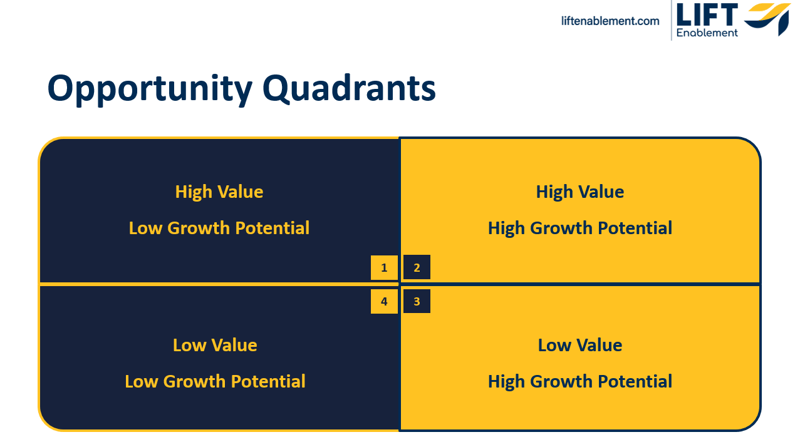How to Increase Revenue (Without Hiring More Salespeople)
 In 2018, I wrote 7 Reasons Hiring Salespeople is the Wrong First Step for Faster Growth to caution against the all-too-familiar move of hiring more salespeople as the primary tactic to generate more new business. That take generated more off-channel conversations and comments than almost anything else I’ve written in over 20 years of blogging.
In 2018, I wrote 7 Reasons Hiring Salespeople is the Wrong First Step for Faster Growth to caution against the all-too-familiar move of hiring more salespeople as the primary tactic to generate more new business. That take generated more off-channel conversations and comments than almost anything else I’ve written in over 20 years of blogging.
At the time, there was a heavy tailwind propelling almost unlimited demand and growth. It was actually difficult not to grow.
Today, businesses find themselves in a very different environment where the option to hire more salespeople is extremely limited. Concerns about the direction of the broader economic environment have led companies to pull back on resources, especially speculative resources that are often used to spur the growth of sales headcount.
That does not give companies an excuse to be any less focused on generating strong growth.
Here are three areas of focus that will measurably grow the volume and quality of your new business.
1. Refine, Redesign, or Refocus Your Selling Proposition to Provoke
In 2004, I “announced” the launch of Imagine (now Lift) with the publication of my first article, “Fighting The Commoditization Trap.” While many aspects of how companies go to market have changed, unfortunately, very few companies have fundamentally changed the underlying approaches that thrust them into the trap.
As Dharmesh Shah has shared, one of the keys to HubSpot’s success is that they don’t try to convince people that they solve a problem better than their competitors. Instead, they highlight and teach a better problem that needs to be solved.
And therein lies the problem sellers face.
Legacy sales approaches don’t connect to the problem centers of the customer/prospect organization.
In short, sales organizations are so solutions-focused that they forget that they’re really in the business of eliminating problems.
So, what’s the secret to success?
Sellers must deliver a strong, provoking, “teaching” point-of-view designed to reframe how customers view their current situation.
The benefits? Sellers are then able to enter the process far earlier, generate high-impact relationships with the role players involved in making important decisions, and enjoy stronger influence on the course and speed of action. This leads to higher average sales and higher margins, with the multiplicative effect of greater retention.
To get started, follow these four steps:
- Focus on addressing an important problem to your TAM/ICP
- Define the problem’s impact the problem, focusing on the areas that are most often missed
- Determine who gets “fired” if the problem isn’t solved
- Deliver an insight that reframes the problem
2. Build and Leverage an Opportunity Quadrant
Very early in my sales career, I had a manager who, as part of my onboarding, said to me, “Doug, there are only two things I need you to do to be successful here. I need you to keep the revenue we have and get more.”
Too young to question what, on the surface, was counsel that was so obvious not to be useful, I sat down and did the only things that made sense. I created a 2x2 matrix. My original matrix was quite simple and looked like this:
|
Quadrant 1 Keep The Business Nothing more to get |
Quadrant 2 Keep The Business Get More |
|
Quadrant 4 Nothing to keep Nothing more to get |
Quadrant 3 Nothing to keep Get More |
I then took each account in my territory and assigned them to a quadrant. I had almost 900 accounts in my territory. I was able to quickly realize that my top 100 accounts accounted for almost 70% of my territory’s revenue, so they made up the top half of the matrix.
After completing my first round of sales calls with them, I was confident that 65 of those accounts also had a lot of opportunities for growth.
Then, given the size of my territory and what was involved in growing my accounts, I estimated that I could be actively working 150 accounts. So my matrix looked like this:
- 35 accounts in Quadrant 1
- 65 accounts in Quadrant 2
- 85 accounts in Quadrant 3
- Everything else in Quadrant 4
This simple grid did two things for me:
- Created the focus I needed to get traction to impact results.
- Provided the context into the actions I needed to take to get the best results from my efforts.
In the process, I discovered something that’s had a tremendous impact on my sales and advisory career since then. The actions and positioning needed to maintain a relationship are very different from those you are trying to grow.
By assigning each of my accounts to a quadrant, I was able to isolate the accounts that needed only to be maintained (Quadrant 1) from those that only needed to be grown (Quadrant 3). Furthermore, I was able to isolate the most complex accounts in my territory - the ones that needed to be maintained and grown (Quadrant 2).
This approach enabled me to transform my territory from one that was in the bottom quartile of the company into the number one performing territory.
Since that time, I’ve prettied up the matrix and refer to it as Opportunity Quadrants™. I’ve used it at every sales position I’ve had since then, and I’ve rolled it out to a plethora of sales teams in multiple industries, with different models and varying levels of sophistication (from both a data and sales perspective).

There is no tool or tactic I’ve ever used that has been as consistently and quickly effective as this. Candidly, my biggest surprise is that when we introduce this to Lift clients, it’s still viewed as a new idea.
3. Assess Your Metrics. Focus on What Causes Sales.
In the last 12 months, I’ve had a front-row seat to watch companies that are struggling because of the challenges in today’s market, as well as those that are thriving.
It’s been a fascinating snapshot of how an organization’s decision-making framework impacts their experience and results.
While I feel bad for many of the companies that are struggling, I have to admit that my empathy for them is rather limited. Why? The results are very much of their making. They jumped on the bandwagon of focusing on efficiency rather than resilience.
And the metrics they use are at the center of causing the problems they're experiencing. Make no mistake; I LOVE data & metrics. But, most companies are applying metrics in a way that is making their business weaker.
The value of the metrics has always been about enabling users to ask better questions. It allows you to get closer to the truth.
The problem begins to emerge when you fail to realize that you’ll never actually get to the truth; you can only get closer to it.
Data is powerful & good when it’s used to ask better questions and improve your thinking; it’s powerful and destructive when used to replace thinking.
Goodhart’s Law states that the moment you take a strong measurement and turn it into an objective, it stops being a good measurement. Modern sales and marketing, for all of its progress, has gotten itself tangled up in the trap.
Rather than focusing almost exclusively on metrics that merely tell you a sale is going to be made (ahem, forecasting), adjust your dashboards to include metrics that are more actionable. Dial in your analytics to identify how you’re doing on those things that cause sales to happen. The challenge for you is that the vast majority of these data points occur earlier than your go-to-market processes even address.
By building stronger capabilities earlier in the cycle, you’ll generate more momentum and velocity. When you don’t do this, you’re trying to grow against gravity, increasing the costs and resources required to maintain growth.

.png)
.png)




